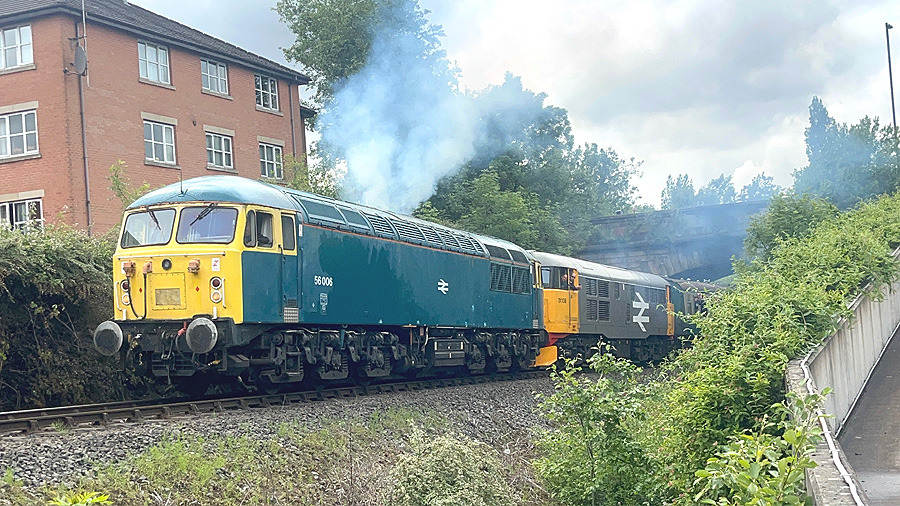
Several recent work parties have seen steady progress on the locomotive. Carried out under the Covid-19 guidelines a three day spell in early September saw several jobs completed.
One of the main ones was the topping up of the traction motor gearcase lubricant. This has been checked previously and although there was lubricant in the gearcases it was below the maximum level and needed topping up. This lubricant provides protection between the pinion (on each of the six traction motors) and the gearwheel which is fitted onto the loco wheelset. The pinion and gear mesh together and lubrication is essential to ensure the high pressures involved do not lead to wear and subsequent failure of either component.
The lubricant is held within the gearcase which acts like a bath with the lubricant filling the bottom few inches . The larger diameter gearwheel dips into the lubricant as it rotates and lubricant clings to the gearwheel and provides lubrication at the critical point where the gearwheel and pinion mesh together.
It all sounds rather straight forward so far- just get some lubricant, pour it in until the level is reached ,repeat 5 more times and go for a brew……..
But of course rule number 1 of class 56 preservation comes into play immediately , and that is simply
“Its a class 56 so nothing that goes wrong is ever accessible or easy”
Rule number 2 also gets a look in too, and that is
” On a class 56 the jobs you think will be easy will be problematic and the jobs you thought would be difficult will be very difficult.
Of course the often underrated rule number 3 often saves the day and that is
” The jobs we thought were going to be problematic or nigh on impossible , will with the right forward planning, enthusiasm , and hard work will become slightly less problematic.”
And so back to the traction motor gearcase lubricant level check (or Job MT02 as it is referred to in the official Class 56 VMOI (Vehicle Maintenance and Overhaul Instruction))
The lubricant itself , which used to be referred to Motak , is expensive . A 20 litre drum costing over £300. So no spilling it .
And there is the second difficulty- it is so viscous that if you did tip the 20 litre drum over you’d quite literally have time to go and make a brew and drink it before any of the lubricant actually dribbled onto the floor. It would be like a waterfall, but in very very slow motion.
Third difficulty – it is not only viscous it is incredibly sticky.
Oh and the filling point is not much larger than the width of your hand and no you can’t just pour it in as the loco body , traction motor and wheelset combine to make access difficult and yes the loco needs to be over a pit to do the job. Are you getting the picture yet?
As with a lot of things the technique is everything. Fortunately one of our volunteers Alan Flockhart is ex UKRL Leicester and had probably done this very task on our other loco 56301. Alan assured us he had a technique and with the loco over the pit Alan produced a box of nitrile rubber gloves, a drum of engine oil and the drum of Motak (Or Lodextrol as its modern equivalent is known- available from Morris Lubricants )
The technique involved putting on a pair of gloves, dipping your hands into the engine oil and then plunging your hands into the Lodextrol and withdrawing a ‘ handful’ . The oil then allows you to work it into a slippery ball which can then be put into the gearcase opening.
Given the gloves have to be changed after only a couple of handfuls its not a quick job but Alan got stuck in (!) and we can now cross it off the list of jobs required on 56006.
One other job was to try and dry out the radiator room floor at number 1 end. This is permanently covered in about 1/2″ (12mm) of water. It does dry out in warm weather leaving a rusty brown powder behind. Given the loco is based in the UK and west of the Pennines its not dry very often.
I’d purchased a syphon pump (with a capacity of a pint and designed for sucking oil out of motorbike engines) and used that to suck up the water from the floor. Several hours and 4 buckets full later I felt reasonably proud of myself. I’d reduced the level to a couple of mm and I felt that would soon dry out as according to the weather forecast we were expecting a spell of decent weather……..
I was on my hands and knees tidying up when I felt something dripping down the back of my neck. It was raining and water was coming in from somewhere. I looked up and it was coming in through one of the covers used to access the radiator elements from inside the locomotive. At first I couldn’t understand why and assumed the bolts securing the cover were not fully tightened which was allowing rainwater to seep past.
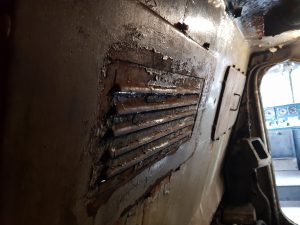
Closer inspection revealed a much more basic problem . As the photograph shows the ventilation louvres in the cover were letting in water because the cover had been fitted upside down. Instead of diverting rainwater the cover was inadvertently channelling rainwater into the locomotive. Removing it, rotating it 180 degrees and refitting seemed to be the simple solution. I hasten to add that the incorrect fitting of the cover had been done by one of the several previous owners (which the log book shows to be EWS but could even likely go back to the last time the loco went through main works which was Doncaster in 1994 whilst 56006 was a Trainload Coal asset)
Of course rule number 2 kicked in when the last bolts was seized and in my rush to try and get the cover refitted to stop the ongoing thunderstorm entering the loco I snapped the small bracket on the cover. This meant it wouldn’t seat correctly when turned 180 degrees and I had to resort to taping up the hole with tarpaulin sheeting to try and keep out the water until the cover could be repaired.
Other jobs have been completed and Mick has organised an electronic copy to be made of our VMOI . This is essentially the ‘Haynes manual ‘ for all jobs required on our class 56. It sets out the scope of the job, the materials needed and the frequency with which the job needs to be undertaken.
We are using the VMOI to carry out a B examination on 56006 and working our way through the list of jobs required. Some are quite technical , but many are straightforward checks and cleaning / painting type jobs which are ideal for any new volunteers wanting to learn their way around a class 56.
Other less glamourous jobs has been the erection of racking in the container at Bury. This racking was kindly donated by my employer.
As you may recall 56006 was running around for a very long time a crazed cab quaterlight on the drivers side at No 1 end. Unfortunately this was broken a few summers ago when some vandals threw a stone through it. The broken glass was removed and a standard Romanian piece of glazing offered into the aperture. Unfortunately it didn’t fit and a piece of hardboard had to be cut to size and fitted and sealed into the aperture. 56006 has run for quite some time with this ‘ distinctive’ look.
Eventually the drier weather allowed us to remove the wooden piece and use it to have a piece of glass specially made to fit.
Several hundred pounds later the glass was offered into the aperture but just didn’t want to go into the space. Eventually it cracked as attempts were made to get it to fit. A piece of Lexan ( toughened plastic) was fitted and that is what is in the loco today.
The problem was put down to the fact 56006 was built in Romania and each cab was probably different from the next.
However a photograph was circulated on facebook which seems to offer an explanation.
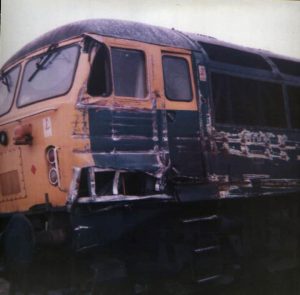
This damage is at the same end of the loco as we have the problem. The loco looks like its had a run in with a MGR hopper and the top edge of the hopper has gouged into the top of the frame where the quarterlight glass was proving very difficult to fit. I’d assumed this was a picture from an incident in Tees yard in 2003 but as Lee Davies pointed out the loco in this picture doesn’t have an orange cantrail stripe which would mean it is a picture of an earlier accident.
Do any members know of any incidents affecting 56006 ? If so we’d love to know any details – it won’t make that blooming glass fit, but it could help expalin why it doesn’t fit.
It also explains why one of the markerlights throws a beam pointing upwards rather than straight and level .
Final work to reunite our mainline registered locomotive 56301 with its replacement tyres(ex 56007) and its original traction motors is underway at UKRL’s Leicester facility and the attached image shows the locomotive during these works. The photo is courtesy of UKRL.
Please remember UKRL’s Leicester site is not open to the public although locomotives on shed can be viewed , as and when local Covid-19 restrictions allow) from the platform ends at Leicester or the road bridge over the MML just north of Leicester station.
56006 – several visits were made during February to attend to 56006 ahead of the anticipated Spring and Summer running days and Gala visits (NYMR and then the home gala at the ELR)
Of course the Covid-19 lockdown then put paid to any further attention to the loco. Fortunately things are now improving and restrictions are being eased. We plan an initial working party on Sunday 5th July and this is restricted to three volunteers and we have been involved with the ELR on risk assesments etc and we will be working to the guidelines issued by the ELR as well as our own common sense about what feels right and what feels wrong. Fortunately diesel locos are made up of several internal compartments so keeping three volunteers in different locations to maintain safe distancing isn’t too much of a problem.
56301- GBRf have issued a purchase order to UKRL covering the swapping of the traction motors onto the ex 56007 bogies and the work is progressing. four motors are removed and two still to remove, 56301 will then be jacked up and reunited with its original traction motors. It will be quite an emotional day for 56301 as the social distancing rules have kept the loco and motors apart for almost as long as the covid-19 lockdown has been in place!
Seriously UKRL expect this work to be completed by the 2nd or 3rd week in July.
We can then look forward to getting 56301 ready for the mainline and wait and see what work is forthcoming.
Sorry for the long gap between updates, which has been down to a combination of the lockdown, working from home and ultimately very little happening to our locos (and little being reported on the railways in general ) because of the lockdown.
Regards
C56G
23rd February 2020.
56301 is now sat on its replacement bogies ( ex 56007) and awaits final reconnection of traction motor cables.
The 6 traction motors were checked for their electrical insulation readings before they left Longport but we’re reading low when checked again at Leicester. The motors will undergo drying out and further insulation tests before they are finally reconnected.
Hopefully 56301 will be returned to traffic soon and updates will be posted here.
29th January 2020
56301 pictured today during bogie exchange at UKRL Leicester Depot ( photo courtesy of UKRL)
56006 ready for work.
56006 will be working top and tail with 47402 (D1501) tomorrow Saturday 18th January on the diesel turn . First run is 0915 from Bury to Heywood and locos will work 3 ROUND TRIPS. 56006 should be leading on Heywood – Rawtenstall legs.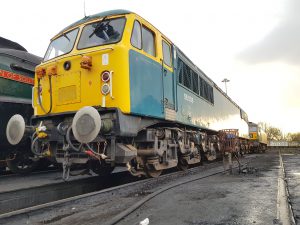
Our small but dedicated team of volunteers will be at Bury all next week and working on a number of jobs which form part of the planned maintenance work which comprises a B exam. Over the coming weeks and months these jobs will be addressed and 56006 will have received a B exam.
We are working to the EWS VMOI document and it is interesting to recall that under BR or EWS such an exam would have taken less than a week on depot.
The timing is not by chance either as the work will ensure 56006 is fit and able to perform it’s booked duties this coming Saturday when it will work the diesel turn in top and tail mode with the fostered ETH loco.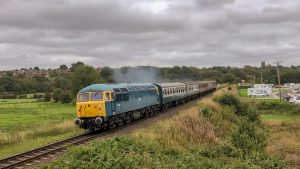
Update 23rd Jan 2020
Bogies arrived at UKRL and 56301 is currently inside shed and worn bogies are disconnected in preparation for exchange which is to take place next week.
12th Jan 2020
GBRf have confirmed the donor bogies have finally been removed from 56007 at Longport and should be delivered to the wheel is the at Doncaster Roberts Road this coming Monday. A quick turnaround is expected and the bogies should arrive at UKRL Leicester on Wednesday.
The schedule for the bogie 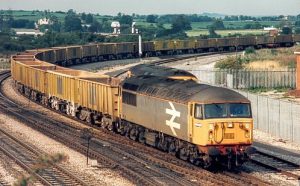 exhange work is not known at this time but UKRL will confirm once they receive the bogies.
exhange work is not known at this time but UKRL will confirm once they receive the bogies.
Updates will follow and hopefully 56301 will be available for potential spot hire work if required.
Available on or ebay site at the following link.
https://www.ebay.co.uk/sch/keith56129/m.html?item=303397158450&hash=item46a3e13e32%3Ag%3A-XMAAOSw08dd7q9R&rt=nc&_trksid=p2047675.l2562
The group took delivery of a 20′ ex shipping container for use as an onsite store and workshop.
This will greatly assist in looking after 56006 as we can transfer parts and tools required to be close by rather than off site or in a car boot.
The container was delivered by Lion Containers who I can thoroughly recommend for this type of purchase.
A further working party took place yesterday (Sat 30/11) and a start made on moving some of the items stored inside 56006. The loco was started and all systems checked and found to be operational. It is our plan to start the loco weekly to try and keep things warm and avoid the problems cased by damp and long periods out of use over the winter.
It is planned to se 56006 on a cople of diesel turns in Febrary, top and tailed with an ETH loco , to ensure the loco is fit and well for the Spring/Summer season

